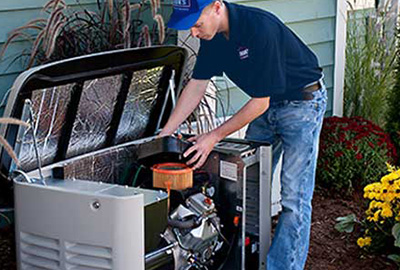
Standby backup generators are indispensable assets in modern society, providing emergency power during main grid failures, be it due to storms, technical glitches, or maintenance activities. Their role in sustaining essential services and operations during power outages cannot be overstated. However, finding that your standby generator won’t start in times of need can be quite stressful. This article aims to be a concise guide, assisting you in backup generator troubleshooting and potentially rectifying common issues that prevent the startup of your generator.
Through this guide, you’ll gain insights and tips to ensure your generator is always ready to spring into action, offering you a dependable power solution during outages.
Understanding Standby Backup Generators
Table of Contents
Key Features of Power Generators
Standby backup generators are notably robust and sophisticated, offering substantial power output and the ability to operate on a variety of fuels such as natural gas, propane, or diesel. A standout feature is their automatic transfer switches, which detect power disruptions and restore the electrical supply seamlessly.
Related Article: Common Whole-House Generator Problems
Comparison with Portable Generators
When compared to portable generators, standby units are leagues ahead in terms of both installation and operation. They are permanently installed outdoors, connected directly to a property’s electrical system, enabling them to supply power automatically upon sensing a disruption, negating the need for manual setup that portable generators necessitate. Moreover, their power output is significantly higher, capable of sustaining entire home es or commercial establishments, unlike the more limited capacity of portable generators.
Importance of Routine Whole-House Generator Maintenance

Maintaining the reliability of a standby backup generator calls for a commitment to regular maintenance. This involves systematic inspections and the timely replacement of worn-out components. Adhering to a maintenance schedule not only guarantees the unit’s operational readiness but also extends its lifespan, solidifying its role as a trustworthy source of power during unforeseen outages.
Securing a professional installation ensures that your standby backup generator is set up correctly, minimizing potential issues down the line and maximizing performance efficiency. Additionally, regular maintenance by experienced technicians is vital in preserving the longevity of the generator, ensuring it operates seamlessly when you need it the most, and complying with warranty stipulations.
Related Article: Tips For Standby Generator Maintenance
Common Reasons Why Standby Backup Generators Won’t Start

- Lack of fuel supply or fuel-related issues: This can encompass various problems, including blocked fuel lines, contaminated or expired fuel, and insufficient fuel levels. It is essential to regularly check the fuel system to ensure smooth operation during emergencies.
- Battery-related problems and electrical issues: These issues might include a dead battery, damaged wiring, faulty alternators, or improper connections. Regular inspections of the electrical components can help in early identification and rectification of these issues.
- Controller and automatic transfer switch (ATS) issues: Malfunctioning ATS may fail to signal the generator to start during a power outage. Controller errors or software glitches might prevent proper startup. Ensuring that the ATS is in good working condition and the controller settings are configured correctly is crucial.
- Engine-related problems: These can range from air intake issues to problems with the coolant or lubrication system. Worn-out components like spark plugs and filters might also hinder the engine’s performance. Routine check-ups can help identify and address engine-related problems before they escalate.
- Faulty sensors and safety mechanisms: Sometimes, the sensors might be over-sensitive or poorly calibrated, triggering false alarms or safety shutdowns. Regular testing and recalibration of sensors and safety systems can help in maintaining the reliability of the generator.
Related Article: Signs it’s Time to Replace Your Standby Generator
Troubleshooting Steps for Standby Backup Generators

Unless you are a trained professional, you should never DIY a generator repair. It is dangerous and can lead to disastrous results. The best that you can do, in this instance, is to write down any issues that you have noticed with your backup generator. This way, you can relay this information to the technician when they arrive. However, some of the backup generator troubleshooting steps that a professional would perform include:
- Step 1: Initial Inspection
- Verify the generator’s physical condition.
- Check for any visible damage or obstructions.
- Step 2: Fuel System
- Ensure an adequate fuel supply.
- Address fuel quality and contamination issues.
- Step 3: Battery System
- Test and replace the backup generator’s battery if necessary.
- Clean and secure battery connections.
- Step 4: Electrical System
- Inspect and reset circuit breakers and fuses.
- Check wiring connections and troubleshoot electrical problems.
- Step 5: Controller and ATS
- Diagnose issues related to the generator’s controller.
- Test the automatic transfer switch for proper operation.
- Step 6: Engine System
- Examine engine-related components for problems.
- Ensure proper lubrication and cooling.
- Step 7: Sensors and Safety Mechanisms
- Troubleshoot and replace malfunctioning sensors.
- Address safety mechanisms that may prevent startup.
Related Article: How To Size A Standby Generator?
Calling a Professional Generator Technician
There are moments when our backup generator troubleshooting efforts simply don’t yield the desired results. In such instances, it’s crucial to understand the importance of seeking the expertise of a certified generator technician. These professionals have the skills and knowledge to accurately diagnose and address issues. Additionally, there might be times when the best course of action is to directly reach out to the generator manufacturer or dealer for specialized service. Recognizing when to call in the experts can save time and prevent further complications.
Related Article: 6 Emergency Power Outage Preparedness Tips
Frequently Asked Questions For Homeowners With Backup Generators

- How often should I test my home’s backup generator? For peace of mind and reliability, it’s a good practice to test your backup generator every month. This ensures it will work as expected when you need it most. Follow the manufacturer’s instructions for testing procedures.
- What’s the typical lifespan of a residential backup generator? The lifespan of a residential backup generator varies based on usage and maintenance. With proper care and regular servicing, many generators can last between 20-30 years.
- How can I ensure my generator will start during an outage? Regular maintenance and monthly testing are crucial. Additionally, ensure that the fuel supply is adequate and that the generator is kept in a clean, dry area. Consider having a professional technician service your generator annually.
- Are there any routine checks I can perform between service visits? Yes, homeowners can perform their own backup generator troubleshooting and check for any visible signs of wear or damage, ensuring that the surrounding area is clean and free from debris. They can also inspect for any oil or coolant leaks. Always refer to the owner’s manual for specific maintenance advice.
- What should I do if my generator isn’t providing power during an outage? First, ensure the generator has sufficient fuel and that there are no tripped circuit breakers. If the problem persists and isn’t something obvious, it’s best to contact a professional technician to diagnose and resolve the issue to avoid causing further damage.
Conclusion
Throughout this article, we have identified various critical factors that can cause standby backup generator startup failures, ranging from fuel and battery-related issues to concerns with the engine and automatic transfer switches. The importance of utilizing professional services for installation and ongoing maintenance stands as a pillar for ensuring optimal functionality and safety. As a final note, we strongly recommend readers to depend on certified technicians for addressing generator concerns, guaranteeing not only a solution to potential problems but also securing peace of mind through reliable and expert care.
Call Skylands Energy Service For All Of Your Standby Generator Needs

Skylands Energy Service is one of the leading generator installation service providers throughout central New Jersey. Aside from backup generator installation, we specialize in generator repair, maintenance, and replacement services. Our team is made up of the best service contractors who are highly trained in advanced methods of generator techniques. Do not hesitate to call or contact us online today to learn more about whole-house generator installation. Rest assured, industry experts will answer all your generator queries. We offer free, in-home estimates. Call Skylands Energy Service today!
Contact us now at (908) 707-1776 to find out more! Click here to view our service area.

